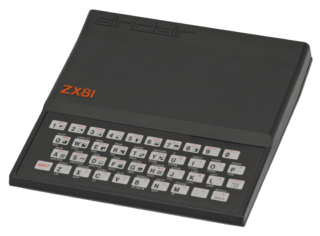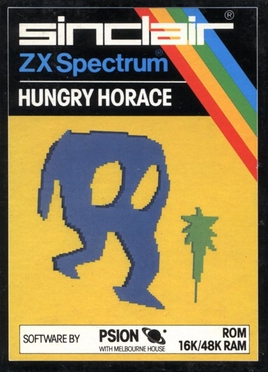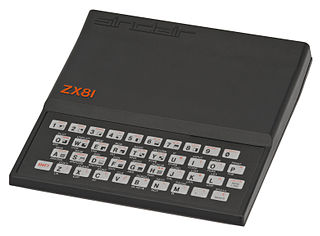Related Research Articles

The Sinclair ZX80 is a home computer launched on 29 January 1980 by Science of Cambridge Ltd.. It is notable for being one of the first computers available in the United Kingdom for less than a hundred pounds. It was available in kit form for £79.95, where purchasers had to assemble and solder it together, and as a ready-built version at £99.95.

The ZX Spectrum is an 8-bit home computer that was developed by Sinclair Research. It was released in the United Kingdom on 23 April 1982, and became Britain's best-selling microcomputer.

The ZX81 is a home computer that was produced by Sinclair Research and manufactured in Dundee, Scotland, by Timex Corporation. It was launched in the United Kingdom in March 1981 as the successor to Sinclair's ZX80 and designed to be a low-cost introduction to home computing for the general public. It was hugely successful; more than 1.5 million units were sold. In the United States it was initially sold as the ZX-81 under licence by Timex. Timex later produced its own versions of the ZX81: the Timex Sinclair 1000 and Timex Sinclair 1500. Unauthorized ZX81 clones were produced in several countries.

Sir Clive Marles Sinclair was an English entrepreneur and inventor, best known for being a pioneer in the computing industry and also as the founder of several companies that developed consumer electronics in the 1970s and early 1980s.
Sinclair BASIC is a dialect of the programming language BASIC used in the 8-bit home computers from Sinclair Research, Timex Sinclair and Amstrad. The Sinclair BASIC interpreter was written by Nine Tiles Networks Ltd.
Sinclair Research Ltd is a former British consumer electronics company founded by Clive Sinclair in Cambridge. It was originally incorporated in 1973 as Westminster Mail Order Ltd, renamed Sinclair Instrument Ltd, then Science of Cambridge Ltd, then Sinclair Computers Ltd, and finally Sinclair Research Ltd. It remained dormant until 1976, when it was activated with the intention of continuing Sinclair's commercial work from his earlier company Sinclair Radionics, and adopted the name Sinclair Research in 1981.

3D Monster Maze is a survival horror computer game developed from an idea by J.K. Greye and programmed by Malcolm Evans and released in 1981 for the Sinclair ZX81 platform with the 16 KB memory expansion. The game was initially released by J. K. Greye Software in December 1981 and re-released in 1982 by Evans' own startup, New Generation Software. Rendered using low-resolution character block "graphics", it was one of the first 3D games for a home computer, and one of the first games incorporating typical elements of the genre that would later be termed survival horror.

The TK90X was a Brazilian ZX Spectrum clone made in 1985 by Microdigital Electrônica, a company from São Paulo, that had previously manufactured ZX80 and ZX81 clones.
Tim Hartnell (1951–1991) was an Australian journalist, self-taught programmer and author of books and magazines on computer games. He set up The National ZX80 User Group with Trevor Sharples in 1980 producing a more-or-less monthly magazine entitled Interface. This User Group then expanded to include the ZX81, Acorn Atom and Spectrum computers, and provided a springboard for Tim and Trevor to launch the first of their home computing books. His company, Interface Publications, produced titles for all of the machines in the home computer market, including Sinclair machines. Hartnell wrote several compendiums of computer games, which typically had several categories of games, with several games in each category. Each category had tips for writing enjoyable games in that genre. Each game had a description of the program and an explanation of its implementation, sometimes with ideas for modifications; this was followed by the raw code, which the reader had to enter into the computer. Some long games, such as Bannochburn Legacy, had more than 500 lines of code.

Hungry Horace is a video game developed by Psion Software Ltd. and published by Sinclair Research in 1982 for Commodore 64, Dragon 32/64, Timex Sinclair 2068, ZX Spectrum, and later for Microsoft Windows and Android. It is the first game in the Horace series. The gameplay is noted to be very similar to Pac-Man, involving the collection of food pellets in a maze while avoiding enemies. Despite this, critical reception of the game was generally positive upon release.

Artic Computing was a software development company based in Brandesburton, England from 1980 to 1986. The company's first games were for the Sinclair ZX81 home computer, but they expanded and were also responsible for various ZX Spectrum, Commodore 64, BBC Micro, Acorn Electron and Amstrad CPC computer games. The company was set up by Richard Turner and Chris Thornton. Charles Cecil, who later founded Revolution Software, joined the company shortly after it was founded, writing Adventures B through D. Developer Jon Ritman produced a number of ZX81 and Spectrum games for Artic before moving to Ocean Software.

Bug-Byte Software Ltd. was a video game company founded in 1980 in Liverpool, initially producing software for the Acorn Atom and ZX80. Bug-Byte's first hit was Don Priestley's Mazogs which was one of the most successful titles for the ZX81. In 1983, it published Manic Miner, considered to be one of the most influential platform games of all time. The company went into liquidation in 1985 but their name and logo were purchased by Argus Press PLC for use as a budget software label.
Cronosoft is a UK-based non-profit software publisher established in 2002, by Simon Ullyatt which manufactures and markets games and utility software for a range of mainly 8-bit computers that are considered "retro" or commercially obsolete.

Rick Dickinson was a British industrial designer who developed pioneering computer designs in the 1980s. Notable examples of his design work include the ZX81 case and touch-sensitive keyboard and the ZX Spectrum's rubber keyboard.

Steve Vickers is a British mathematician and computer scientist. In the early 1980s, he wrote ROM firmware and manuals for three home computers, the ZX81, ZX Spectrum, and Jupiter Ace. The latter was produced by Jupiter Cantab, a short-lived company Vickers formed together with Richard Altwasser, after the two had left Sinclair Research. Since the late 1980s, Vickers has been an academic in the field of geometric logic, writing over 30 papers in scholarly journals on mathematical aspects of computer science. His book Topology via Logic has been influential over a range of fields. In October 2018, he retired as senior lecturer at the University of Birmingham. As announced on his university homepage, he continues to supervise PhD students at the university and focus on his research.

The Sinclair ZX Printer is a spark printer which was produced by Sinclair Research for its ZX81 home computer. It was launched in 1981, with a recommended retail price of £49.95.

The ZX Spectrum character set is the variant of ASCII used in the ZX Spectrum family computers. It is based on ASCII-1967 but the characters ^, ` and DEL are replaced with ↑, £ and ©. It also differs in its use of the C0 control codes other than the common BS and CR, and it makes use of the 128 high-bit characters beyond the ASCII range. The ZX Spectrum's main set of printable characters and system font are also used by the Jupiter Ace computer.
Richard Francis Altwasser is a British engineer and inventor, responsible for the hardware design of the ZX Spectrum.

Sinclair Programs was a magazine published in the United Kingdom, initially by ECC Publications of London and subsequently by EMAP. It was originally dedicated entirely to listings for programs for the Sinclair Research ZX80, ZX81 and ZX Spectrum computers, contributed by readers. ZX80 listings no longer appeared after the May 1983 issue. Letters and software review pages were added in the March 1984 issue.
References
- AZUA, The Australian ZX Users' Association, Canberra, Australia, Vol 2, No 11, ISSN 0811-4749
- The Australian Sinclair Gazette, AZUA, Canberra Australia, Vol 6, No 3, 1986, ISSN 0811-4749